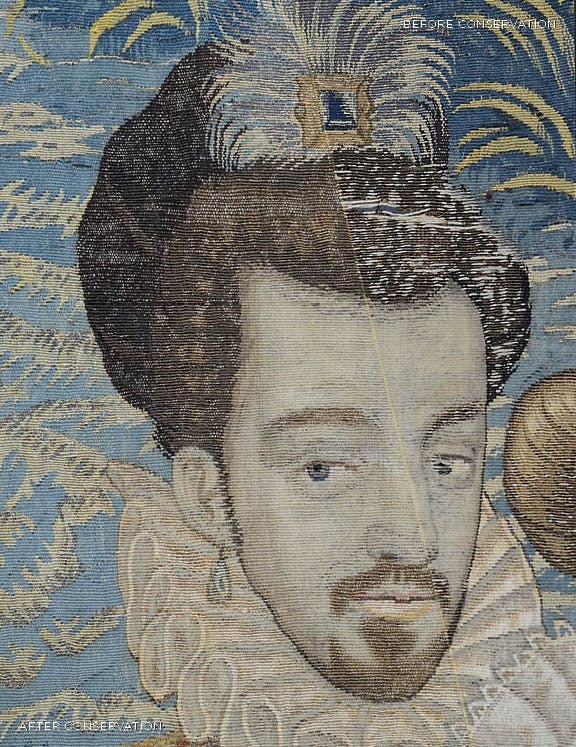
- Magazine Article
- Conservation
- Exhibitions
Magnificent Encore
Painstaking conservation has returned Catherine de' Medici's Renaissance hangings to their original glory

Fontainebleau (details), from the Valois Tapestries, c. 1576, before and after conservation
Renaissance Splendor: Catherine de’ Medici’s Valois Tapestries tells a captivating tale of art, power, and patronage at the French royal court. Queen mother of France from the 1560s through the 1580s, Catherine de’ Medici was well versed in using artistic displays and lavish entertainments to demonstrate the wealth and majesty of the Valois monarchy.
The Valois Tapestries are surely the most vivid manifestation of this enterprise. Woven in Brussels in the mid-1570s, they record in exquisite detail the grand entertainments—called “magnificences”—that Catherine staged to celebrate important family reunions, diplomatic visits, and political events. After Catherine’s death in 1589, the tapestries passed to her granddaughter Christina of Lorraine, who brought them to Florence that year when she married Ferdinand I de’ Medici, Grand Duke of Tuscany. Eventually the Valois Tapestries became the property of the Gallerie degli Uffizi in Florence, where they are housed today. The current exhibition in Cleveland marks their North American debut.


The most recent episode in the tapestries’ history is one of the most fascinating: an ambitious conservation project, begun in 1998 and completed in 2018, represents an achievement nearly equal to the hangings’ creation 450 years ago. Although the Valois Tapestries are reasonably well preserved for textiles of their age, over the centuries they had become too fragile to be safely displayed. A detailed condition survey identified the problems to be addressed, which included deeply embedded dust and dirt, deteriorated fibers, small holes and tears, and the oxi-
dation of precious metal-wrapped threads.
After testing for colorfastness of the centuries-old dyes, the conservators worked in small sections and gently washed each tapestry. Oxidation was removed using a weak chemical solution and a soft brush, allowing the silver and gilded silver metal-wrapped threads to glitter once again. To repair losses and deteriorated fibers, wool and silk threads were specially spun to match those in the original tapestry and dyed using modern recipes that safely re-created historic dyes. Minute stitches stabilized losses and restored visual integrity. Finally, a linen lining was hand-stitched to the reverse of each restored tapestry to help support its weight while hanging and to prevent further damage to the delicate threads. To facilitate the display of the tapestries, strips of Velcro were sewn onto a piece of heavier linen, which was then sewn to the top of the lining fabric.
Years of skilled, painstaking work have made it possible to appreciate once again the monumental ambition and regal extravagance of Catherine de’ Medici’s Valois Tapestries.

Cleveland Art, January/February 2019